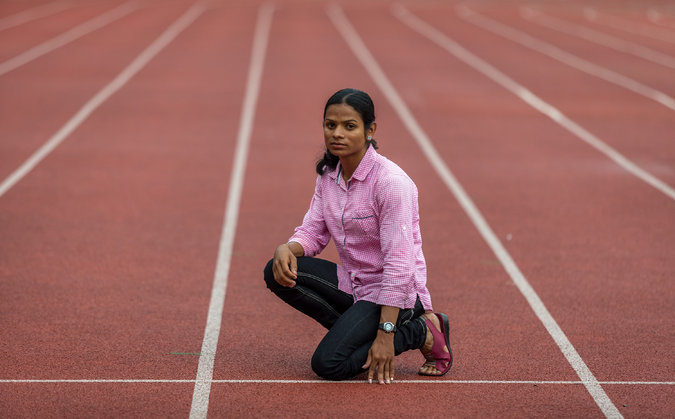Caster Semenya is a woman. One might think this is in doubt, however, judging from a barrage of recent comments swirling around the internet as news and social media weighed in on the South African runner’s blistering win in the 800 meters last Friday in Monaco. “Gender Dispute Rumbles as Semenya Goes for Gold,” one headline blasted, appearing everywhere fromTimes Live in South Africa to France 24 and Yahoo Sports.
The International Association of Athletics Federations (IAAF) cleared Semenya to compete in 2010. Yet people refuse to decouple this athlete from the period in which, in her words, she was
“subjected to unwarranted and invasive scrutiny of the most intimate and private details of my being… [that] infringed on not only my rights as an athlete but also my fundamental and human rights including my rights to dignity and privacy.”
Even now, six years on, as she prepares for Rio, nearly every report on Semenya’s race times doggedly refers to this investigation and the questions about her gender that sprang from it.
Stories like these are harmful. They continue the cruel and humiliating media speculation she has endured and reignite the fires of speculation and gossip. They need to stop.
Sprinter Dutee Chand, India’s first female Olympian in 36 years to compete in the 100 meters at the Rio Games, faces similar public appraisal. She is also a woman. But readers might have assumed otherwise upon seeing her on the cover of the New York Times Magazine earlier this month. Stamped over her image, in giant, 351-point Pepto-Bismol pink font, are the letters “XX” and “XY” — representing what many understand to be female and male “sex” chromosomes.
Although the article “The Humiliating Practice of Sex Testing Female Athletes,” is a searing critique of the IAAF’s hyperandrogenism regulationsand expresses Chand’s humiliation at being misgendered, the cover art calls into question Chand’s sex, gender, and gender identity. In doing so, it perpetuates the very harm the article intends to critique.
In 2014, Chand was investigated and banned under IAAF policies that establish a ceiling for women’s testosterone levels based on presumptions of unfair advantage. The Court of Arbitration for Sport has since ruled in favor of Chand’s appeal and suspended the policies, and today women compete without being required to submit to unnecessary interventions to lower their T levels.
Chand and Semenya have won the right to compete in Rio on the track, after years of dedication and hard work, like everyone else. They have the support of the highest court in world sport. They’ve overcome prejudice with courage and determination. And they deserve our admiration and respect. Not only for their courage, but also for their exceptional athletic talent.
Instead, this dehumanizing speculation, commentary, and depiction isintensifying in the lead-up to Rio where both will compete.
The relentless comments include the media’s and public’s willingness to scrutinize their bodies, question their identity, and invade their privacy with impunity. Such representations invite unwelcome speculation about the configuration of these athletes’ genitals, whether they have ovaries or testes, and whether their chromosomes are XX or XY. Too many have made assumptions about their hormone levels based on how they look and how they perform, questioning whether they should be allowed to compete, or even be considered women at all. One journalist disturbingly called women subject to investigation “uncategorised” — a declaration indicative of the kind of privilege that comes from having a body or gender presentation that escapes such scrutiny.
The violation of privacy has taken place in ways horrifying and yet predictable. Karla Holloway, the James B. Duke Professor of English & Professor of Law at Duke University, has noted that privacy is implicitly reserved for socially-privileged groups: male, white, heterosexual. Living outside these interlocking privileges means inhabiting a body that is always, to some extent, treated as public and open to scrutiny, probing, and coercion in way invisible to the institutions and individuals doing the looking. It is thus not surprising the vast majority of the women investigated under the IAAF policies have been brown or black women from the Global South.
The specific treatment Chand and Semenya received during official investigation and after has been horrifyingly resonant with the medicalized, racist use of black women’s bodies as “infotainment.” This kind of inspection — examining female athletes as if they are specimens — reeks eerily of longstanding histories of scientific fascination with imagined sexual peculiarities of women of color. These include the display of Sartje Baartman as the “Hottentot Venus” and the public gynecological exams and surgeries performed on enslaved African-American women by J. Marion Sims.
These representations in story and image are connected to and conducive of discrimination and physical forms of gender-regulating violence that are shockingly common around the world. Only two days after Chand appeared on the cover of the Times magazine, the newspaper reported an “epidemic of anti-gay violence” in Rio.
Too many in the Global North have not appreciated the ramifications of being investigated and scrutinized for the livelihood of the individuals in question, their relationships, their freedom of movement, and their safety. The resulting stigma can lead to social ostracization, threatening career loss and decreased wages, the ability to marry, and one’s deeply felt sense of self.
What will their experience be in Rio, and later, throughout their lifetime, as they navigate a media and sports world that seems to steadfastly label them as they wish, disregarding science and, yes, their feelings?
These comments and images matter. Calling into question an athlete’s sense of self, their very identity, after they have said, explicitly, as both did, “This hurts and harms me,” is violence. Those in the position to tell their stories, and others who comment on them in the public sphere, have an ethical responsibility to refrain from assaulting their spirits, bodies, and autonomy. It is an obligation we all have and must fulfill.
Follow me on Twitter.

